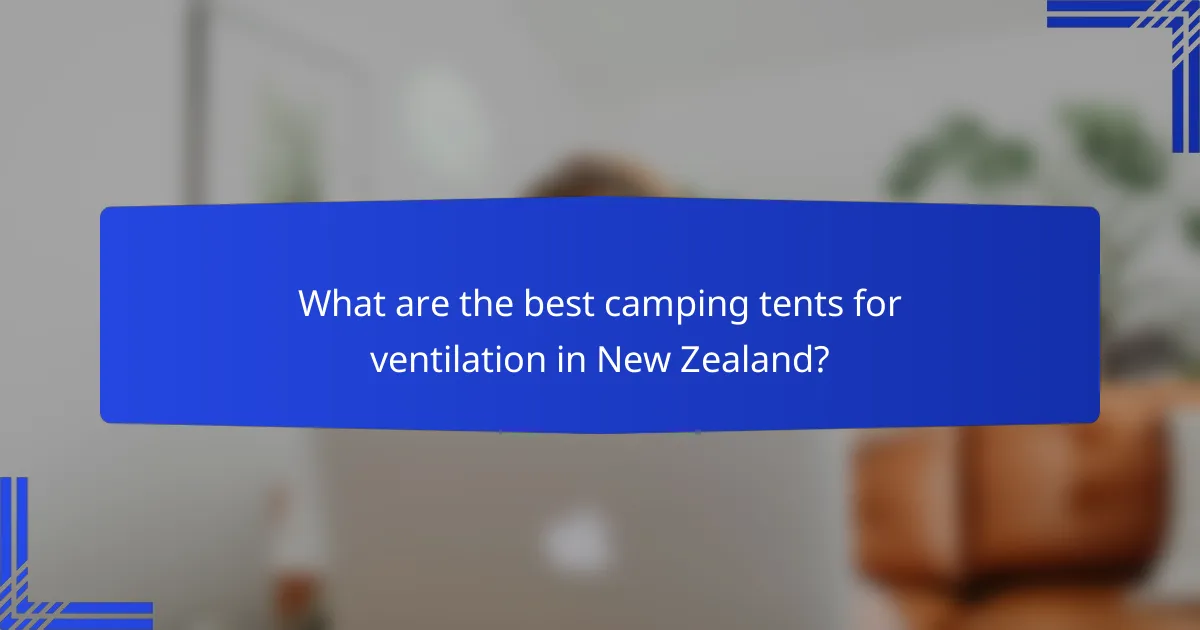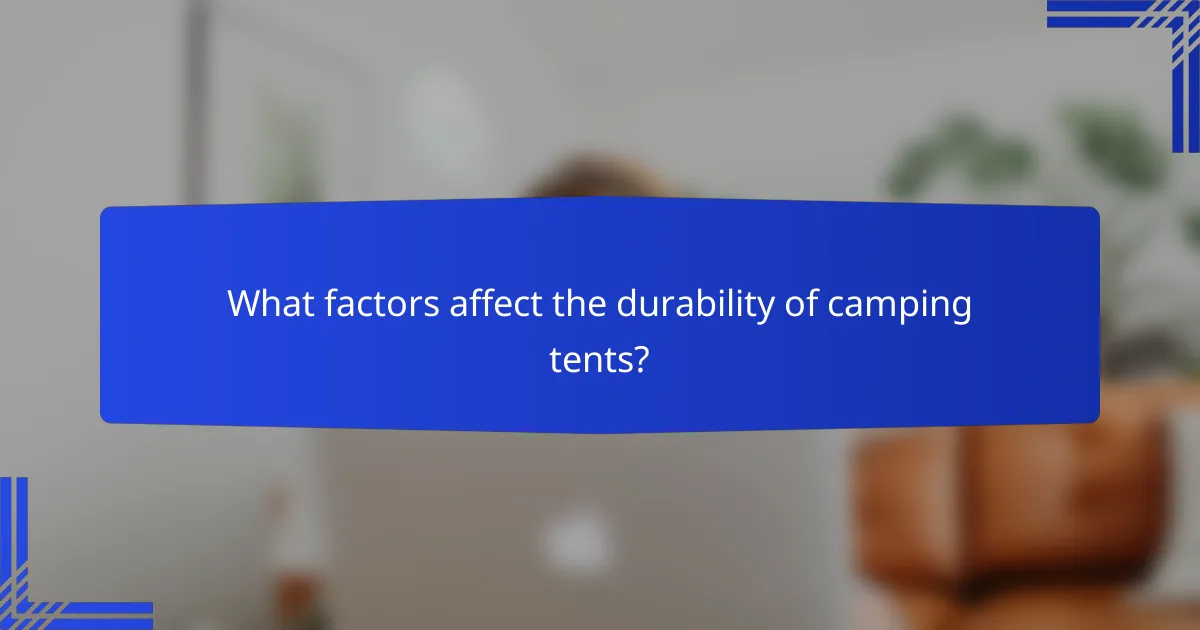Choosing the right camping tent involves considering key factors such as ventilation, setup ease, and durability. Tents with multiple mesh panels and adjustable vents provide excellent airflow, essential for comfort in varying weather. Additionally, tents designed with color-coded poles and quick-setup mechanisms simplify assembly, while high-quality materials and robust construction ensure long-lasting performance in the great outdoors.

What are the best camping tents for ventilation in New Zealand?
The best camping tents for ventilation in New Zealand typically feature multiple mesh panels and adjustable vents to enhance airflow. These designs help reduce condensation and maintain a comfortable environment during varying weather conditions.
Big Agnes Copper Spur HV UL
The Big Agnes Copper Spur HV UL is renowned for its excellent ventilation, thanks to its high-volume architecture and extensive mesh panels. This tent allows for ample airflow while still providing protection from the elements, making it ideal for New Zealand’s diverse climate.
When setting up, the tent’s lightweight design and color-coded webbing simplify the process, allowing for quick assembly in under five minutes. Its durable materials ensure longevity, even with frequent use in rugged terrains.
MSR Hubba NX
The MSR Hubba NX is another top choice for ventilation, featuring a rainfly that can be adjusted for optimal airflow. Its unique design includes a large mesh canopy, which promotes excellent breathability while keeping bugs out.
This tent is easy to set up, often taking around ten minutes, and is built to withstand harsh weather conditions. Its robust construction and thoughtful design make it a reliable option for camping in New Zealand’s variable weather.

How easy is it to set up different camping tents?
The ease of setting up camping tents varies significantly based on design and features. Generally, tents that utilize color-coded poles and quick-setup mechanisms allow for faster assembly, while more complex structures may require additional time and effort.
REI Co-op Half Dome SL
The REI Co-op Half Dome SL is designed for quick and straightforward setup, taking around 5 to 10 minutes for most users. Its color-coded poles and hub system simplify the process, making it accessible even for beginners.
This tent features a two-pole design that provides stability while remaining lightweight. It’s an excellent choice for backpackers who prioritize both ease of setup and portability.
Kelty Dirt Motel
The Kelty Dirt Motel offers a unique design that allows for a fast setup, typically within 10 to 15 minutes. Its freestanding structure and intuitive pole system make it user-friendly, especially for family camping trips.
This tent is spacious and durable, providing ample room for gear. However, its slightly heavier weight compared to other options may be a consideration for solo backpackers.

What factors affect the durability of camping tents?
The durability of camping tents is influenced by material quality, weather resistance, and overall construction. Understanding these factors can help you choose a tent that withstands the rigors of outdoor use over time.
Material quality
The quality of materials used in a tent significantly impacts its durability. High-denier fabrics, such as nylon or polyester, are generally more resistant to wear and tear compared to lower-quality options. Look for tents made with ripstop fabric, which features a grid pattern that helps prevent tears from spreading.
Additionally, consider the tent’s waterproof coating. A higher hydrostatic head rating, typically above 3000 mm, indicates better water resistance, which is crucial for longevity in wet conditions. Always check for reinforced seams and quality zippers, as these areas are often the first to show signs of wear.
Weather resistance
Weather resistance is essential for ensuring a tent’s durability in various conditions. Tents designed for specific weather types, such as 3-season or 4-season tents, offer varying levels of protection against rain, snow, and wind. A 4-season tent, for example, is built to withstand harsher weather and is typically made from sturdier materials.
When selecting a tent, pay attention to features like a rainfly, which provides an extra layer of protection against moisture, and a sturdy pole structure that can handle strong winds. Investing in a tent with good weather resistance will not only enhance its durability but also improve your overall camping experience.

What are the top-rated camping tents for ease of setup?
The top-rated camping tents for ease of setup typically feature simple designs that allow for quick assembly, often in under 10 minutes. Look for tents with color-coded poles, pop-up mechanisms, or hub systems to streamline the process.
Naturehike Cloud Up
The Naturehike Cloud Up is known for its lightweight design and straightforward setup, making it a favorite among solo campers. With a freestanding structure and a single-pole system, it can be pitched quickly, often in just a few minutes.
This tent is made from durable materials, ensuring it withstands various weather conditions while remaining easy to transport. Its compact size and low weight make it ideal for backpacking trips, where setup speed is crucial.
Vango F10 Xenon UL
The Vango F10 Xenon UL is designed for ultralight backpackers who prioritize ease of setup without sacrificing durability. Featuring a unique tension band system, this tent can be erected quickly, providing stability and protection against wind.
Its materials are engineered for strength and lightweight performance, allowing for a comfortable camping experience. The tent’s design also focuses on ventilation, ensuring airflow while keeping the setup process efficient.

How does ventilation impact camping tent comfort?
Ventilation significantly affects camping tent comfort by regulating temperature and humidity levels inside the tent. Proper airflow helps maintain a pleasant environment, preventing discomfort caused by heat or moisture buildup.
Prevents condensation
Good ventilation is essential for preventing condensation inside a camping tent. When warm, moist air from your breath or sweat meets cooler surfaces, it can lead to water droplets forming on the tent walls. This moisture can create a damp environment, making your sleeping area uncomfortable.
To minimize condensation, choose a tent with multiple vents or mesh panels that allow humid air to escape. Additionally, setting up your tent in a well-ventilated area, away from water sources, can help reduce moisture levels.
Enhances airflow
Enhancing airflow in a camping tent contributes to overall comfort by regulating temperature and reducing stuffiness. Tents with adequate ventilation systems, such as adjustable vents or mesh windows, allow fresh air to circulate, keeping the interior cooler during warm weather.
When selecting a tent, consider models that offer cross-ventilation options. This feature allows air to flow through the tent from one side to the other, improving comfort significantly. Additionally, during hot nights, you can open vents or windows to create a breeze, ensuring a more restful sleep.

What are the key features to consider when choosing a camping tent?
When selecting a camping tent, prioritize ventilation, ease of setup, and durability. These features significantly impact your comfort and experience while camping, especially in varying weather conditions.
Weight and packability
Weight and packability are crucial for campers who need to carry their gear over long distances. Lightweight tents typically weigh between 1 to 3 kg, making them easier to transport. Consider tents that pack down to a small size, allowing for efficient storage in your backpack.
When choosing a tent, look for models with compression sacks or those that can be easily rolled up. This feature enhances portability and ensures you can fit all your gear without hassle.
Seasonality and weather conditions
Understanding the seasonality and weather conditions is vital for selecting the right camping tent. Tents are generally categorized into three-season and four-season models, with three-season tents suitable for spring, summer, and fall, while four-season tents are designed to withstand harsher winter conditions.
Consider the climate where you will be camping. If you expect rain, look for tents with a waterproof rating of at least 1,500 mm. For windy areas, choose a tent with a sturdy frame and guy lines for stability. Always check the weather forecast and prepare accordingly to ensure a safe and enjoyable camping experience.

How do camping tents compare in terms of price?
Camping tents vary significantly in price based on features, materials, and brand reputation. Budget options can be found for under $200, while premium tents often exceed $500, offering advanced durability and design.
Budget options under $200
Budget camping tents typically range from $50 to $200 and are suitable for casual campers or short trips. These tents often prioritize affordability over advanced features, making them a great choice for beginners or occasional use.
When selecting a budget tent, consider factors like weight, ease of setup, and ventilation. Look for models that offer good weather resistance and adequate space for your needs, as some may be less durable in harsh conditions.
Premium options over $500
Premium camping tents, priced over $500, are designed for serious campers and outdoor enthusiasts. These tents often feature high-quality materials, superior weather resistance, and advanced ventilation systems, making them suitable for extended trips in various climates.
Investing in a premium tent can provide benefits such as increased durability and comfort. Many of these tents include additional features like multiple rooms, built-in storage solutions, and quick setup mechanisms, enhancing the overall camping experience.
